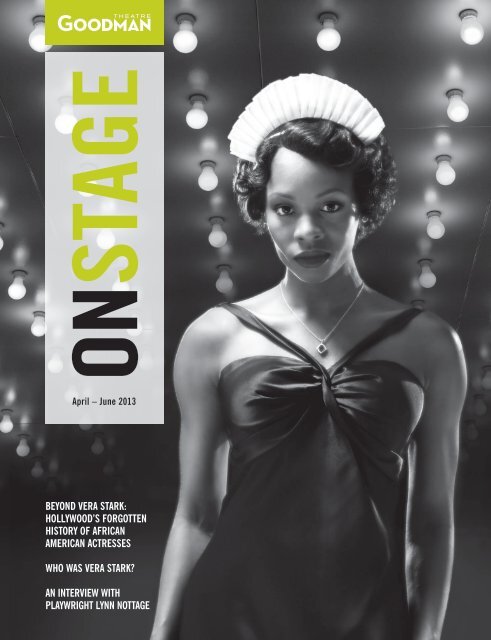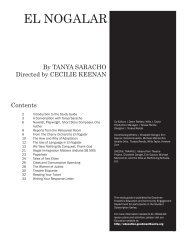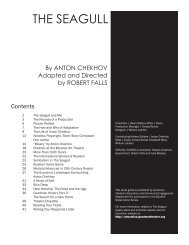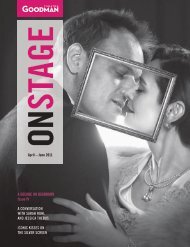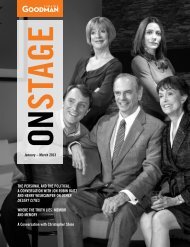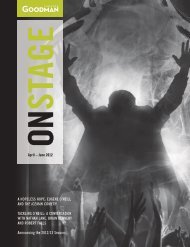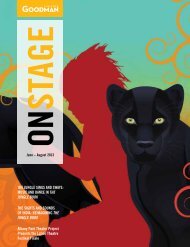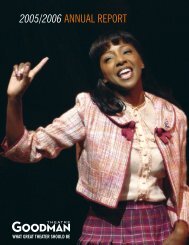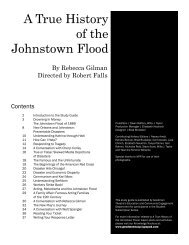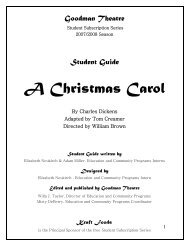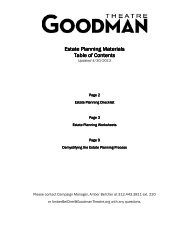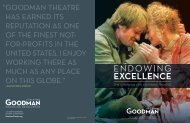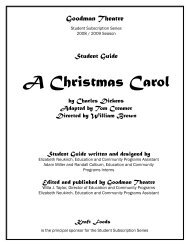BEYOND VERA STARK: HOLLYWOOD'S ... - Goodman Theatre
BEYOND VERA STARK: HOLLYWOOD'S ... - Goodman Theatre
BEYOND VERA STARK: HOLLYWOOD'S ... - Goodman Theatre
Create successful ePaper yourself
Turn your PDF publications into a flip-book with our unique Google optimized e-Paper software.
April – June 2013<br />
<strong>BEYOND</strong> <strong>VERA</strong> <strong>STARK</strong>:<br />
HOLLYWOOD’S FORGOTTEN<br />
HISTORY OF AFRICAN<br />
AMERICAN ACTRESSES<br />
WHO WAS <strong>VERA</strong> <strong>STARK</strong>?<br />
AN INTERVIEW WITH<br />
PLAYWRIGHT LYNN NOTTAGE
April – June 2013<br />
CONTENTS<br />
In the Albert<br />
2 Beyond Vera Stark: Hollywood’s Forgotten History of<br />
African American Actresses<br />
6 Who Was Vera Stark?<br />
7 An Interview with Playwright Lynn Nottage<br />
At the <strong>Goodman</strong><br />
10 Insider Access Series<br />
11 Two New Resident Artists Join the <strong>Goodman</strong><br />
In the Wings<br />
12 Dark Eyes: Visions of Black Women<br />
Scene at the <strong>Goodman</strong><br />
13 Fame, Fantasy, Food, Adventure Auction a Success!<br />
Teddy Ferrara Opening Night<br />
14 Measure for Measure Opening Night<br />
The Latino <strong>Theatre</strong> Festival Celebration featuring Pedro Páramo<br />
15 Teddy Ferrara Diversity Night<br />
Off Stage<br />
16 The <strong>Goodman</strong> Welcomes our New Trustees<br />
For Subscribers<br />
17 Calendar<br />
VOLUME 29 #4<br />
Co-Editors | Lesley Gibson, Lori Kleinerman,<br />
Tanya Palmer<br />
Graphic Designer | Amanda Good<br />
Production Manager | Lesley Gibson<br />
Contributing Writers/Editors | Neena Arndt,<br />
Jeff Ciaramita, Lisa Feingold, Katie Frient,<br />
Lesley Gibson, Lori Kleinerman, Dorlisa<br />
Martin, Julie Massey, Tanya Palmer, Teresa<br />
Rende, Victoria Rodriguez, Denise Schneider,<br />
Steve Scott, Willa J. Taylor, Kate Welham.<br />
OnStage is published in conjunction with<br />
<strong>Goodman</strong> <strong>Theatre</strong> productions. It is<br />
designed to serve as an information source<br />
for <strong>Goodman</strong> <strong>Theatre</strong> Subscribers. For ticket<br />
and subscription information call<br />
312.443.3810. Cover: Image design and<br />
direction by Kelly Rickert.<br />
<strong>Goodman</strong> productions are made possible<br />
in part by the National Endowment for<br />
the Arts; the Illinois Arts Council, a state<br />
agency; and a CityArts grant from the City<br />
of Chicago Department of Cultural Affairs<br />
and Special Events.<br />
Written comments and<br />
inquiries should be sent to:<br />
The Editor, OnStage<br />
<strong>Goodman</strong> <strong>Theatre</strong><br />
170 North Dearborn Street<br />
Chicago, IL 60601<br />
or email us at:<br />
OnStage@<strong>Goodman</strong><strong>Theatre</strong>.org
IN THE ALBERT<br />
FROM THE ARTISTIC DIRECTOR<br />
Photo by Dean LaPrairie.<br />
Why By the Way, Meet Vera Stark?<br />
When you think of the great American screen actresses of the 1930s, who comes to mind? Bette Davis?<br />
Joan Crawford? Jean Harlow, perhaps, or Greta Garbo? Marie Dressler? How about Nina Mae McKinney?<br />
Fredi Washington? Or Alice B. Russell, Louise Beavers or the beautiful Dorothy Van Engle? Or perhaps the most<br />
enigmatic of them all, Vera Stark? If the images of those last six women don’t come readily to mind, it is likely<br />
because their careers were defined not by their beauty, their talent or their chemistry onscreen, but by their<br />
African American heritage. In a time when mainstream female screen stars could be blonde or brunette, sleek<br />
or full-figured, exotically foreign or all-American, there was one thing that they all had in common: they were<br />
white. For black actresses of that era, there were only a few choices. They could work in the relatively tiny<br />
world of all-black films, as did Russell, Van Engle and McKinney (reputedly one of that era’s great beauties).<br />
They could follow the example of dancer/singer Josephine Baker and seek fame in another country. Or they<br />
could toil in small roles in mainstream films, portraying maids, nannies or other types of domestics—the kinds<br />
of parts that brought minor fame (and steady employment) to Beavers, Ethel Waters and Hattie McDaniel,<br />
whose portrayal of Mammy in the iconic Gone with the Wind made her the first African American Oscar winner.<br />
And what of Vera Stark? Her anonymity is actually the result of a different circumstance: she is the fictional<br />
creation of Pulitzer Prize–winning playwright Lynn Nottage, the centerpiece of Nottage’s newest play By the<br />
Way, Meet Vera Stark. The story of Vera Stark mirrors that of dozens of ambitious, talented actresses of color<br />
in the 1930s: scoring unexpected success from a role as a maid in a ’30s historical blockbuster, she quickly<br />
disappears from the mainstream screen, leaving later generations of fans and critics to dissect her all-too-brief<br />
career and celebrate a presence that, in a different time, might have achieved greatness and lasting celebrity.<br />
By turns funny, poetic, smart and incisive, Vera’s saga becomes that of an entire generation of artists<br />
unknown to most of us, artists whose beauty and talent were lost in the racial marginalization of America in<br />
the mid-twentieth century. And, true to her reputation as one of our most inventive and eloquent writers, Lynn<br />
has created other platforms upon which to explore the story of Vera at greater length, particularly two websites<br />
(FindingVeraStark.com and MeetVeraStark.com) that flesh out in even greater detail the life and legend<br />
of Vera Stark. These websites, “created” by two fictional characters from the play, operate as though Vera<br />
were real—a storytelling method employed by the playwright as a commentary on the virtually anonymous<br />
treatment of African Americans in old Hollywood.<br />
It is my great, great pleasure to welcome Lynn back to the <strong>Goodman</strong> and to pair her once again with<br />
Resident Director Chuck Smith, who directed Lynn’s Crumbs from the Table of Joy here in 2006. Together<br />
with a talented team of designers and actors, they will bring to the <strong>Goodman</strong> stage the truth behind the<br />
legend of one of Hollywood’s most elusive icons—and the society that created, then stifled, her.<br />
Robert Falls<br />
Artistic Director
IN THE ALBERT<br />
Beyond Vera Stark: Hollywood’s Forgotten<br />
History of African American Actresses<br />
By Jamila Woods<br />
She wears a white apron tied around<br />
her plump frame, a kerchief knotted<br />
to her head, and sports a widetoothed<br />
grin. James Baldwin once<br />
asked, “How many times have we seen<br />
her?” From twentieth-century minstrel<br />
show stages to pancake mix boxes<br />
to Hollywood screens, her name has<br />
changed but her characteristics have<br />
always remained about the same.<br />
The housemaid, servant or “Mammy”<br />
character has become one of the most<br />
iconic portrayals of African American<br />
women in US media to date. But while<br />
audiences know her character well,<br />
the names and faces of the actresses<br />
who portrayed her in Hollywood’s early<br />
years are often not recognized by the<br />
general public, instead lost in time and<br />
obscured by an industry that confined<br />
them to the background for decades.<br />
Lynn Nottage’s By the Way, Meet Vera<br />
Stark introduces contemporary theater<br />
audiences to one of these overlooked<br />
talents in a two-part tableau that<br />
examines the life and afterlife of littleknown<br />
black actress Vera Stark*. The<br />
play begins in the days leading up to<br />
her Hollywood film debut in 1933,<br />
then jumps forward to a modern-day<br />
academic panel that pores over footage<br />
of her final television appearance<br />
in 1973 on The Brad Donovan Show—<br />
right before she disappeared without a<br />
trace—in an attempt to shine light on<br />
her life and unravel the mystery of her<br />
later years. Like most black Hollywood<br />
actresses of her time, many of the<br />
details of Vera’s story are still largely<br />
unknown. And though Nottage’s play<br />
focuses primarily on one actress’<br />
2
OPPOSITE: Hattie McDaniel and<br />
Vivien Leigh in a scene from the<br />
film Gone with the Wind, 1939.<br />
(Photo by Metro-Goldwyn-Mayer/<br />
Getty Images)<br />
forgotten life and career, it reveals<br />
the constant struggles of generations<br />
of overlooked actresses deprived of<br />
opportunities to find rewarding work<br />
and decent representation in the<br />
film industry.<br />
In the years leading up to the 1930s,<br />
two major developments in American<br />
society had critical effects on the<br />
role of African American women<br />
in Hollywood films. The first was<br />
the stock market crash in 1929.<br />
Hollywood’s pre-Depression era representation<br />
of blacks had been blatantly<br />
negative, often portraying slaves as<br />
evil insurgents threatening the white<br />
race—most notably in 1915’s The<br />
Birth of a Nation, a silent film set in<br />
Reconstruction era South that depicts<br />
an anarchistic black militia takeover of<br />
a South Carolina town. But the devastating<br />
effects of the Great Depression<br />
left the American economy in shambles<br />
and highlighted the growing tensions<br />
between racial groups. In response,<br />
American cinema began to provide<br />
much-needed escapism for the masses<br />
during a time of crisis and churned out<br />
a series of Southern epic films set on<br />
peaceful plantations, meant to remind<br />
viewers of the “good old days” of<br />
American prosperity. These films portrayed<br />
slavery in a gracious light, and<br />
often featured happy slaves who sang<br />
spirituals and all but worshipped their<br />
white masters. Commercial filmmakers<br />
of the time learned that larger audiences<br />
and profit margins came from<br />
depicting the ease, wealth and benign<br />
race relations of plantation life, and the<br />
ever-present “Mammy” figure became<br />
an integral part of this image.<br />
The second major development in film<br />
during this time was the introduction<br />
of “talkies,” or films with sound.<br />
The end of the silent film era led to a<br />
push for verisimilitude and authenticity<br />
in pictures, and audiences came to<br />
expect real black bodies and voices on<br />
screen. As a result, producers finally<br />
started seeking African American actors<br />
to play African American characters<br />
in their films. Gone were the days of<br />
minstrelsy and white actors silently<br />
mimicking “black” motions and facial<br />
expressions in blackface. But even with<br />
the increase in acting roles opening up<br />
for blacks in Tinseltown, the variety<br />
of roles available for African American<br />
actors was still severely limited.<br />
As Ralph Ellison once noted, “Movies<br />
are not about blacks but what whites<br />
think about blacks.” In the 1930s and<br />
onward, African American actresses in<br />
mainstream Hollywood films had no<br />
choice but to portray stereotypes largely<br />
constructed by the white imagination. To<br />
achieve the supposedly authentic “Negro<br />
dialect,” many movie studios hired<br />
white dialect coaches to teach African<br />
American actresses to speak in an exaggerated<br />
Southern drawl. Black actresses<br />
were also often typecast to specific roles<br />
based on their skin tone and physical<br />
appearance. Darker skinned, heavyset<br />
women were frequently cast as<br />
“Mammy” characters. Hattie McDaniel<br />
and Ethel Waters, two actresses bestknown<br />
for their portrayal of maids in<br />
popular films, both had to force-feed<br />
themselves at several points in their<br />
careers in order to maintain the overweight<br />
figure filmmakers desired for their<br />
characters. As film historian Ed Guerrero<br />
writes, “In almost every instance, the<br />
representation of black people on the<br />
commercial screen has amounted to one<br />
grand, multifaceted illusion.”<br />
“I’d rather play a maid and make $700<br />
a week than be a maid and make $7.”<br />
—Hattie McDaniel<br />
But these actresses often found their<br />
own ways of existing as artists within a<br />
restrictive industry; some embraced the<br />
available roles and tried to breathe a<br />
semblance of humanity into otherwise<br />
one-dimensional characters. Hattie<br />
McDaniel, most famous for her role as<br />
Mammy in Gone with the Wind (1939),<br />
became known for her portrayal of<br />
sassy, opinionated maids in motion pictures.<br />
“I loved Mammy,” McDaniel once<br />
said in an interview. “I think I understood<br />
her because my own grandmother<br />
worked on a plantation not unlike<br />
[Mammy’s].” McDaniel’s screen presence<br />
was a force to be reckoned with,<br />
often putting white film critics on edge<br />
with her energetic, witty performances,<br />
which some claimed threatened to<br />
*Vera Stark, Gloria Mitchell, Herb Forrester<br />
and Carmen Levy-Green are fictional characters<br />
created by playwright Lynn Nottage<br />
as a commentary on the treatment of<br />
African American actors in early cinema.<br />
FEATURED SPONSOR: ITW<br />
“ITW is proud to support the <strong>Goodman</strong>’s<br />
production of By the Way, Meet Vera Stark.<br />
The <strong>Goodman</strong> is renowned for first-rate theater<br />
and this will be another great example. At<br />
ITW, we are thrilled with our partnership with<br />
<strong>Goodman</strong> <strong>Theatre</strong>.”<br />
-Maria C. Green, Senior VP and General<br />
Counsel, Illinois Tool Works, <strong>Goodman</strong> Trustee<br />
3
IN THE ALBERT<br />
No matter how many films African American actresses<br />
appeared in, they were inevitably most remembered for<br />
their work in servile supporting roles.<br />
upstage her white co-stars. Vera Stark<br />
is also said to be one of the actresses<br />
who deliberately breathed new life into<br />
an otherwise flat stereotypical role.<br />
Unlike McDaniel, her most famous<br />
film was made in pre-code Hollywood,<br />
before strict rules governing onscreen<br />
race relations were enacted in 1934.<br />
Vera was dubbed “cheesecake served in<br />
a brown paper bag: a leading lady in a<br />
maid’s uniform,” and her nuanced and<br />
genuine performance as Tilly in The<br />
Belle of New Orleans (1933) disrupted<br />
the traditional image of black maids as<br />
simple-minded subservient characters,<br />
imbuing her with a depth which suggested<br />
she was “at once in the role<br />
and commenting on it.” Still, these performances<br />
were not always valued as<br />
revolutionary or subversive by the wider<br />
black community.<br />
Although McDaniel won an Academy<br />
Award for her performance in Gone with<br />
the Wind—the first black actor to ever<br />
do so—she faced heavy scrutiny from<br />
the NAACP and black audiences for<br />
what they saw as perpetuating negative<br />
and demeaning images of the race.<br />
McDaniel infamously responded to<br />
these critics by saying, “I’d rather play<br />
a maid and make $700 a week than be<br />
a maid and make $7.” Louise Beavers,<br />
known for her portrayal of maid Delilah<br />
in Imitation of Life (1934), faced similar<br />
criticism from the NAACP, to which<br />
she responded, “I am only playing the<br />
parts, I don’t live them.” But the distinction<br />
between the roles they played<br />
in pictures and their off-screen identities<br />
was unfortunately never that simple.<br />
No matter how many films African<br />
American actresses appeared in, they<br />
were inevitably most remembered for<br />
their work in servile supporting roles.<br />
Prominent black actresses of the 1930s<br />
and ’40s interviewed later in their<br />
careers frequently fixated on their early<br />
work in maid roles, even if they moved<br />
on to star in all-black films or portrayed<br />
other types of characters. As Vera Stark<br />
stated in her 1973 interview with Brad<br />
Donovan, “It’s been the subject of my<br />
life for the past 40 years; yes I am trying<br />
to change the subject.”<br />
This kind of treatment eventually drove<br />
some African American actresses to<br />
push back against Hollywood’s representation<br />
of black women. Butterfly<br />
McQueen, who acted alongside<br />
INDIVIDUAL SUPPORT FOR<br />
BY THE WAY, MEET <strong>VERA</strong><br />
<strong>STARK</strong><br />
<strong>Goodman</strong> <strong>Theatre</strong> is proud to acknowledge<br />
the following individuals for their support of<br />
the 2012/2013 Season and By the Way, Meet<br />
Vera Stark.<br />
The Edith-Marie Appleton Foundation/Albert<br />
and Maria <strong>Goodman</strong><br />
Julie and Roger Baskes<br />
Ruth Ann M. Gillis and Michael J. McGuinnis<br />
Principal Major Sponsors<br />
Patricia Cox<br />
Andrew “Flip” Filipowski and Melissa Oliver<br />
Sondra and Denis Healy/Turtle Wax, Inc.<br />
Carol Prins and John H. Hart<br />
Alice Rapoport and Michael Sachs/Sg2<br />
Merle Reskin<br />
Leadership Major Sponsors<br />
Nancy Lauter McDougal and Fred McDougal<br />
Artistic Collective Sponsors<br />
Sherry and Tom Barrat<br />
Don and Rebecca Ford Terry<br />
Kimbra and Mark Walter<br />
Randy and Lisa White<br />
Director’s Society Sponsors<br />
Julie M. Danis and Paul F. Donahue<br />
Harry J. Harczak, Sr. Memorial Foundation<br />
Student Subscription Series Sponsors for By the<br />
Way, Meet Vera Stark<br />
Commitments as of April 8, 2013<br />
4
McDaniel as a maid in Gone with the<br />
Wind, was very outspoken in her rejection<br />
of the negative portrayal of blacks<br />
in the film. “I was suffering the whole<br />
time,” she said, “I didn’t know that I’d<br />
have to be just a stupid little slave. I<br />
wouldn’t let Vivien Leigh slap me, and<br />
I wouldn’t eat watermelon. I was very<br />
sensitive about that.” Others resisted<br />
the restrictions of their roles in subtler<br />
ways. Vera Stark recounts having to<br />
“fight tooth and nail” to utter the last<br />
line in The Belle of New Orleans, as<br />
the producers originally “didn’t want a<br />
Negrowoman to have the final word.”<br />
Many African American actresses<br />
eventually found such treatment intolerable<br />
and sought political outlets for<br />
their frustrations. Fredi Washington,<br />
who played Louise Beavers’ daughter<br />
in Imitation of Life, quit acting early<br />
on, became a civil rights activist and<br />
co-founded the Negro Actors Guild of<br />
America, where she worked to create<br />
better opportunities for black actors.<br />
Vera Stark also eventually shunned<br />
stereotypical roles and became involved<br />
OPPOSITE: Clinton Sundberg, Louise Beavers and Ann<br />
Sheridan in a scene from the movie Good Sam, 1948.<br />
(Photo by Mondadori Portfolio via Getty Images). LEFT:<br />
Tamberla Perry as Vera Stark. Photo by Brian Kuhlmann.<br />
in the civil rights movement as an avid<br />
supporter of other Negro artists, fashion<br />
designers and musicians. But others<br />
reacted less constructively, and many<br />
black actresses ended up turning to<br />
drugs or alcohol, or simply disappearing<br />
into uncredited extra roles. Such<br />
was the quandary often faced by black<br />
women in Hollywood: work demeaning<br />
roles (and often risk alienating their<br />
own community), or not work at all.<br />
In Lynn Nottage’s play we are reminded<br />
of an important set of histories that<br />
have long remained unspoken. Vera<br />
Stark’s character operates as a standin<br />
for all of the forgotten or uncredited<br />
African American actresses throughout<br />
Hollywood history who never had the<br />
chance to be properly introduced to<br />
the American public. By the Way, Meet<br />
Vera Stark presents a story that refuses<br />
to be swept into a “dusty old trunk,” in<br />
hopes that today’s audiences might be<br />
inclined to look more critically at representations<br />
of African American women<br />
not only in early Hollywood, but on<br />
today’s screens and in films for years<br />
to come.<br />
The Belle<br />
of New<br />
Orleans<br />
The film adaptation of The Belle of<br />
New Orleans starred screen legend<br />
Gloria Mitchell*, but more interestingly,<br />
it launched the controversial<br />
career of African American actress<br />
Vera Stark. Vera’s performance was<br />
recognized by the Academy with a<br />
nomination for Best Supporting<br />
Actress, making her the first<br />
African American to receive such<br />
an honor. She was subsequently<br />
signed to a multi-year contract at<br />
Celestial Pictures, but the studio<br />
squandered her talent on bit parts<br />
in B-movies. After the implementation<br />
of the notorious Hays Motion<br />
Picture Production Code in 1934,<br />
the studio didn’t know how to cast<br />
the beautiful African American<br />
actress, and she was relegated to<br />
such throwaway roles as maids<br />
and hat-check girls. Racism stifled<br />
Vera’s career at the very moment it<br />
was blossoming.<br />
Vera would nevertheless go on to<br />
make over 55 films in Hollywood,<br />
including God’s Fitful Chilluns,<br />
Five Stolen Kisses and Songs of<br />
Dixie. Later, she would have a<br />
modest though undistinguished<br />
career on television, playing stereotypical<br />
black characters in<br />
shows such as Lumus and Larry.<br />
AMERICAN EXPRESS SUPPORTS FAÇADE RESTORATION AT<br />
THE GOODMAN<br />
<strong>Goodman</strong> <strong>Theatre</strong> is pleased to recognize American Express for its generous support during the 2011/2012<br />
and 2012/2013 Seasons as Façade Restoration Sponsor.<br />
Each year, the <strong>Goodman</strong> serves over 200,000 patrons through its broad array of productions and outreach<br />
programs, providing valuable enrichment and generating millions in economic activity in the downtown area.<br />
With American Express’ support, the <strong>Goodman</strong> is able to undertake preservation efforts on the façade of its<br />
Dearborn Street facility, helping the theater serve as a bedrock cultural institution for generations to come.<br />
The <strong>Goodman</strong> salutes American Express for its commitment to the preservation of historic sites and monuments<br />
that are vital to attracting visitors and revitalizing neighborhoods, and for its role in ensuring the<br />
long-term vitality of the theater.<br />
5
IN THE ALBERT<br />
Vera Lula Stark* (1910-1973?) was<br />
born in South Brooklyn to Hattie and<br />
Lewis Stark, popular performers on the<br />
black vaudeville circuit known as TOBA<br />
(Theater Owners Booking Association).<br />
Vera’s maternal grandmother was the<br />
legendary music hall singer and contortionist<br />
Ida “burnt pretzel” McCleary.<br />
When Vera was five years old she joined<br />
the family act on the road, where she<br />
competed for the spotlight with her cousin,<br />
a talented tap dance sensation. Vera<br />
was a standout performer, yet the Stark<br />
family was never able to achieve mainstream<br />
success. They lived from hand<br />
to mouth until Lewis Stark was banned<br />
from the circuit for pistol-whipping a<br />
notoriously corrupt white theater owner<br />
who owed him money.<br />
In the mid-1920s, Vera fled to<br />
Hollywood along with a wave of talented<br />
African American vaudeville performers<br />
from around the country in search of<br />
work in the emerging talking pictures.<br />
For several years she appeared as an<br />
uncredited extra in numerous shorts,<br />
and found herself taking on odd jobs to<br />
make ends meet, including working as<br />
white actress Gloria Mitchell’s maid.<br />
Who Was Vera Stark?<br />
By Carmen Levy-Green*<br />
a year in the life of two slave sisters in<br />
New Orleans: Marie, the beautiful and<br />
whimsical octoroon prostitute who falls<br />
hopelessly in love with a white Southern<br />
planter; and steadfast Tilly, her devoted<br />
servant and companion. The novel was<br />
originally conceived as an indictment<br />
of slavery and the caste system in the<br />
deep South. It was even viewed by<br />
some during that period as a provocative<br />
anti-slavery narrative. Cited as vulgar<br />
and unseemly, The Belle of New Orleans<br />
was publicly burned in front of the state<br />
capital in Louisiana on June 16, 1853<br />
and subsequently banned throughout<br />
the South by politicians threatened by<br />
its sexual and racial politics. Yet, inconceivably,<br />
the book went on to become<br />
an underground sensation, spawning<br />
popular theatrical spectacles that toured<br />
the nation in the late nineteenth and<br />
early twentieth century.<br />
Gorgeous, self-possessed, immensely<br />
talented and hopelessly self-destructive,<br />
Vera continued to work on and off until<br />
1973, but she would never match the<br />
success, promise or fame found in her<br />
first film, The Belle of New Orleans.<br />
In her private life, Vera was plagued by<br />
misfortune. She had two unsuccessful<br />
marriages, the first to Leroy Barksdale,<br />
a popular trumpet player with the Petie<br />
Owens Orchestra. During an infamous<br />
performance at the Humming Bird<br />
Ballroom, a white heckler repeatedly<br />
shouted racial epithets at Barksdale. He<br />
snapped, and in his rage inadvertently<br />
beat the heckler to death with his trumpet.<br />
Vera stood by Barksdale throughout<br />
the highly publicized trial, but at the<br />
urging of her creative representatives<br />
she ended the relationship in order to<br />
save her flagging career. But the scandal<br />
was to follow her for many years. In<br />
1952, Vera married middle-weight prize<br />
fighter Dortch Ross. It was a tumultuous<br />
and sometimes violent relationship,<br />
and during their short-lived marriage she<br />
began drinking heavily. Alcohol and prescription<br />
medications would become her<br />
constant companions, costing her roles<br />
and burning many bridges in Hollywood.<br />
In the late 1960’s and early ’70’s,<br />
legendary agent Scottie Hudson tried<br />
to revive Vera’s career. Finally, after a<br />
number of very lean and difficult years,<br />
he booked her an engagement at the<br />
Folies Bergere in Las Vegas. During<br />
the now infamous performance, Vera<br />
stripped naked in the middle of singing<br />
“Heat Wave” and was arrested for public<br />
indecency. A week later she disappeared<br />
without a trace.<br />
A maid, a coat check girl, a down-andout<br />
blues singer, Vera, like an entire generation<br />
of African American actresses,<br />
was a ubiquitous though often uncredited<br />
presence on the silver screen. Vera<br />
flew just under the radar, and her talent<br />
was squandered on mediocre roles in<br />
forgettable films. Racism in Hollywood<br />
robbed Vera of a career, but also robbed<br />
audiences throughout the world of<br />
access to her shining talent.<br />
Vera’s big break came in 1933, when<br />
famed Hollywood director Maximillian<br />
Von Oster gambled his career on a film<br />
adaptation of a little-known Southern<br />
novel called The Belle of New Orleans,<br />
written by Bernard St. Simon in 1852.<br />
The novel, a classic melodrama, follows<br />
*See note on page 3.<br />
UPPER LEFT: Vera Stark as a young girl. LEFT: Leroy<br />
Barksdale.<br />
6
IN THE ALBERT<br />
An Interview with<br />
Playwright Lynn Nottage<br />
By Carmen Levy-Green*<br />
On an exceptionally balmy summer<br />
night in 1947, a fire alarm pierced<br />
the midnight calm of a sleepy community<br />
in Burbank, California. An outof-control<br />
fire raged in an enormous<br />
storage warehouse on the back lot of<br />
Celestial Pictures. Five engine companies<br />
heroically battled the blaze well<br />
past dawn. Unbeknownst to them, the<br />
warehouse contained hundreds of highly<br />
flammable nitrate film negatives, resulting<br />
in a blaze that spread dangerously<br />
fast. By the time the last flame was<br />
extinguished, nearly all of the original<br />
negatives and prints of films made by<br />
Celestial Pictures were destroyed. It was<br />
a monumental loss.<br />
On that night in 1947 the film industry<br />
also lost something else: African<br />
American actress Vera Stark*. She spent<br />
nearly two decades on contract with<br />
Celestial Pictures, and the fire ruined<br />
much of the celluloid records of her early<br />
film career. Indeed, Vera’s cinematic legacy<br />
was destroyed in the fire; The Belle<br />
of New Orleans is one of the few surviving<br />
films that feature the unburnished<br />
and nascent talent of Vera Stark.<br />
When I was eight years old I saw The<br />
Belle of New Orleans, and since that<br />
first encounter I have been hungry to<br />
know and understand Vera Stark as she<br />
was before she vanished from our collective<br />
memories. There was a time when<br />
Vera was one of the most promising<br />
African American actresses in Hollywood,<br />
commanding a salary unprecedented for<br />
a woman of color. In my book Hollywood<br />
Dreams (Robeson Press), I attempt to<br />
retrace Vera’s tragic life and career, and<br />
in doing so tell the story of a generation<br />
of African American performers whose<br />
contributions to early Hollywood were<br />
obscured by racism.<br />
So I was initially leery and suspicious<br />
when I learned about the play<br />
By the Way, Meet Vera Stark. The<br />
Pulitzer Prize–winning playwright Lynn<br />
Nottage claimed to shed some light<br />
on an actress in need of resurrection.<br />
Thankfully, I had the opportunity to<br />
sit down for an informal conversation<br />
with Ms. Nottage. I found her to be<br />
open, funny and quite passionate on<br />
the subject of Vera Stark. As a scholar<br />
and avid film buff, I entered the conversation<br />
skeptical, but I was quickly<br />
won over and eventually allowed her<br />
to include my voice in the play. Below<br />
is an excerpt from a longer interview,<br />
which can be found on my website<br />
FindingVeraStark.com.<br />
Carmen Levy-Green: Why did you<br />
decide to write a play about Vera Stark?<br />
ABOVE: Lynn Nottage<br />
Lynn Nottage: I’ve always had an<br />
incredible fascination with old black and<br />
white films from the 1930s. When I was<br />
young, I’d stay up late into the night<br />
watching them. It was like rummaging<br />
through your favorite antique shop<br />
looking for hidden treasures. I loved<br />
the old films, but I was always terribly<br />
embarrassed by the grotesque and stereotypical<br />
ways African Americans were<br />
portrayed. When black actors appeared<br />
on screen, I’d find myself temporarily<br />
taken out of the movie, and often had to<br />
recalibrate my emotions before jumping<br />
back into the narrative. But every once<br />
in a while I’d catch a glimpse of an actor<br />
in a film who seemed to be peeking out<br />
and commenting on the world beyond<br />
the mask of their character. So with Vera<br />
Stark, I wanted to explore the life of<br />
actors beyond the mask. I decided to use<br />
humor to uncover the painful and passionate<br />
journey that they (then and even<br />
now) are forced to take on in order to ply<br />
their trade. I also wanted to engage with<br />
the images of blackness on screen, and<br />
try to make sense of the difficult choices<br />
that actors had to make at times when<br />
their options were very limited.<br />
SPECIAL THANKS TO ALBERT AND MARIA GOODMAN,<br />
WHO CONTINUE THEIR LONGSTANDING SUPPORT OF<br />
CHUCK SMITH BY BEING MAJOR PRODUCTION SPONSORS<br />
OF BY THE WAY, MEET <strong>VERA</strong> <strong>STARK</strong>.<br />
7
IN THE ALBERT<br />
“Every once in a while I’d catch a<br />
glimpse of an actor in a film who<br />
seemed to be peeking out and<br />
commenting on the world beyond<br />
the mask of their character.”<br />
—Lynn Nottage<br />
CLG: A fire destroyed much of our<br />
record of Vera Stark’s career, so how<br />
did you learn about her?<br />
LN: Like so many of us, I first came<br />
to love Vera in the movie The Belle of<br />
New Orleans. But I will be honest: it<br />
wasn’t easy to piece together the fragments<br />
of her life. Actresses like Vera<br />
Stark are elusive, and because of the<br />
limited information in circulation it’s<br />
hard to really get to know them. There<br />
are a number of well-documented iconic<br />
African American actresses from the<br />
1930s and ’40s, however, we know<br />
most of them via the cringe-inducing<br />
roles they were relegated to playing.<br />
But interestingly enough, artists like<br />
Vera Stark who attempted to present<br />
more complicated and realistic portrayals<br />
of black women were overlooked,<br />
marginalized by the industry because<br />
they didn’t feed Hollywood’s warped<br />
notion of what it meant to be black.<br />
So trying to find film clips and articles<br />
about Vera proved nearly impossible.<br />
I was fortunate enough to encounter<br />
your website [FindingVeraStark.<br />
com] and that of Herb Forrester*<br />
[MeetVeraStark.com]. Herb proved<br />
to be a font of information and was<br />
invaluable to my process.<br />
CLG: What was the most surprising<br />
thing you discovered while writing<br />
the play?<br />
LN: I think the most surprising discovery<br />
I made while writing the play<br />
was how closely Vera’s struggles mirror<br />
those of African American actresses<br />
today. Has there been progress? Yes, of<br />
course. I don’t want to diminish that.<br />
But it’s shocking and frustrating how the<br />
film industry’s perspective on African<br />
American women remains so narrow<br />
and distorted. I am constantly pushing<br />
up against it with my own work.<br />
CLG: What can you tell me about<br />
Gloria Mitchell, who starred in The<br />
Belle of New Orleans? I have my own<br />
thoughts, which you definitely touch<br />
upon in the play.<br />
LN: Gloria Mitchell was a talented<br />
actress. Like Vera, much of her legacy<br />
was destroyed in that now infamous<br />
fire at Celestial Pictures. It was a real<br />
tragedy, because Gloria was one of the<br />
biggest stars in Hollywood, but unfortunately<br />
The Belle of New Orleans is one<br />
of the only complete films that captures<br />
her allure.<br />
CLG: My mother came of age in the<br />
1960s and was always very critical<br />
of my interest in black folk in early<br />
cinema. She was dismissive of many<br />
of the actors because she still lived<br />
very much in the shadow of the stereotypical<br />
characters they portrayed. She<br />
could be quite unforgiving.<br />
LN: I understand, and it is easy to feel<br />
that way. I certainly have my moments.<br />
BELOW: Gloria Mitchell as a young girl.<br />
GOODMAN THEATRE WOMEN’S BOARD SPONSORS BY THE<br />
WAY, MEET <strong>VERA</strong> <strong>STARK</strong><br />
The <strong>Goodman</strong> Women’s Board continues a long tradition of support for exciting and challenging work with<br />
its sponsorship of By the Way, Meet Vera Stark. Since its formation in 1978, the Women’s Board has made<br />
part of its mission the sponsorship of a production every season, as well as providing crucial funding for<br />
the <strong>Goodman</strong>’s Education and Community Engagement programs.<br />
<strong>Goodman</strong> <strong>Theatre</strong> gratefully salutes the Women’s Board as a Major Production Sponsor of By the Way, Meet<br />
Vera Stark, and thanks its members for their dedication and generosity to the theater.<br />
8
IN THE ALBERT<br />
However, the play is not an indictment<br />
of the actors but rather an exploration<br />
of their difficult journey. I recognize<br />
that the images on the screen are painful,<br />
but they are not the totality of who<br />
those actors were. And that is what<br />
I’m exploring: who were they?<br />
CLG: How do you think Vera Stark<br />
would feel about the play?<br />
LN: I hope that Vera would be flattered.<br />
I think that she might take issue with<br />
some of the truths that we expose, but I<br />
feel it is an accurate, though irreverent,<br />
take on old Hollywood. Like you, Vera<br />
is a fictional character I created to draw<br />
people into a dialogue about race and<br />
representation in early cinema.<br />
Carmen Levy-Green* is an associate professor<br />
of gender and media studies at USVC. She<br />
has spent her life watching and writing about<br />
cinema. She is the author of two critically<br />
acclaimed books, Hollywood Dreams (Robeson<br />
Press) and Black Glitter (San Jose Press).<br />
Finding Vera Stark<br />
The story of Vera Stark doesn’t end when the curtain goes down. Playwright<br />
Lynn Nottage has created an innovative multi-platform process for telling her<br />
character’s tale that jumps from the stage to the (computer) screen through two<br />
websites (FindingVeraStark.com and MeetVeraStark.com) devoted to unraveling<br />
the mystery behind her legacy—and creating an offstage forum for an honest<br />
examination of race. This experimentation with form isn’t new to the Pulitzer<br />
Prize winner, as she’s carved out a reputation over the years as a groundbreaking<br />
and chameleonic writer of (primarily) African American women’s stories. Though<br />
her protagonists are of similar ethnic backgrounds, each of her works are firmly<br />
rooted in a specific place and time, and take on a distinct tone—ranging from<br />
slapstick comedy to heart-wrenching drama. Her best-known plays include the<br />
arresting 2008 Ruined, which tells the tales of the inhabitants of a Congolese<br />
brothel amid a violent civil war; 2003’s Intimate Apparel, a carefully wrought<br />
character study set in 1905 Manhattan; and Fabulation or, The Re-Education of<br />
Undine, an irreverent satire dubbed “of the MTV generation” by its author that<br />
takes us to the projects of present-day New York.<br />
But with the creation of By the Way, Meet Vera Stark’s accompanying websites,<br />
Nottage takes the next step into experimentation with form. The sites serve to<br />
flesh out the details of Vera’s legacy through photographs, telegrams, films and<br />
newspaper articles, all posted as clues into her elusive life and mysterious disappearance.<br />
By presenting this information in this format, Nottage is creating an<br />
offstage commentary on the state of race in the early days of Hollywood: after<br />
all, African American actresses of Vera’s era were so anonymous, the average<br />
person will likely buy into the myth that she actually existed.<br />
*See note on page 3.<br />
FEATURED SPONSOR:<br />
WBEZ<br />
“WBEZ 91.5FM produces and broadcasts, onair<br />
and online, content representing diverse<br />
viewpoints and expressions to local, regional<br />
and national audiences. As a proud media<br />
sponsor of By the Way, Meet Vera Stark, we<br />
applaud <strong>Goodman</strong> <strong>Theatre</strong> for its longstanding<br />
commitment to embracing all voices and<br />
cultures in its works.”<br />
-Judy Lindsey, Vice President of Philanthropy,<br />
WBEZ 91.5FM/Chicago Public Media, Inc.<br />
Support Diverse Voices at the <strong>Goodman</strong><br />
as a By the Way, Meet Vera Stark<br />
Community Engagement Partner<br />
This spring, the <strong>Goodman</strong> is offering donors an opportunity to partner with us in celebration<br />
of our production of By the Way, Meet Vera Stark. Community Engagement<br />
Partnerships are a unique way to support the theater’s diversity initiatives with a taxdeductible<br />
gift of $500, which comes with an array of benefits—including, but not<br />
restricted to, VIP tickets for related Diversity Night and Women’s Night events.<br />
To pledge your support as a Community Engagement Partner for By the Way,<br />
Meet Vera Stark—including an invitation Women’s Night on May 8—contact Molly<br />
McKenzie at 312.443.3811 ext. 597 or MollyMcKenzie@<strong>Goodman</strong><strong>Theatre</strong>.org.<br />
9
AT THE GOODMAN<br />
Want to Learn More About What<br />
Inspires the Work on Our Stages?<br />
Discover the Insider Access Series.<br />
Insider Access is a series of public programs that provide insight into the <strong>Goodman</strong>’s artistic process. Take advantage of these events to<br />
enrich your <strong>Goodman</strong> experience.<br />
BY THE WAY, MEET <strong>VERA</strong> <strong>STARK</strong><br />
ARTIST ENCOUNTER:<br />
BY THE WAY, MEET <strong>VERA</strong> <strong>STARK</strong><br />
A Discussion with Playwright Lynn Nottage and<br />
Director Chuck Smith<br />
Sunday, May 5 | 5 – 6pm<br />
Polk Rehearsal Room<br />
<strong>Goodman</strong> <strong>Theatre</strong> Artist Encounters bring together audiences<br />
and the artists who create the work on our stages in an intimate<br />
environment, for a behind-the-scenes look at the plays<br />
and the playmaking process. Join us for an in-depth conversation<br />
on the creation of this sly new satire from Pulitzer<br />
Prize winner Lynn Nottage.<br />
FREE for Subscribers, Donors and students with ID; $5 for the<br />
general public. Reservations are required. Call 312.443.3800<br />
to reserve your seats.<br />
PLAYBACK: BY THE WAY, MEET <strong>VERA</strong> <strong>STARK</strong><br />
Following each Wednesday and Thursday performance of By<br />
the Way, Meet Vera Stark, Albert <strong>Theatre</strong> audiences are invited<br />
to attend free PlayBacks, post-show discussions with members<br />
of the artistic team.<br />
FREE<br />
BY THE WAY, MEET <strong>VERA</strong> <strong>STARK</strong> PRE-SHOW<br />
DISCUSSIONS<br />
Members of the <strong>Goodman</strong>’s artistic staff will host pre-show<br />
discussions before select performances of By the Way, Meet<br />
Vera Stark.<br />
Pre-show discussions begin at 7pm in the upper lobby on May<br />
10, May 17, May 24 and May 31.<br />
FREE<br />
THE JUNGLE BOOK<br />
BEHIND THE SCENES: THE JUNGLE BOOK<br />
Thursday, May 16 | 6 – 7pm<br />
The Art Institute of Chicago, Fullerton Hall<br />
FREE with purchase of admission to museum<br />
<strong>Goodman</strong> Associate Producer Steve Scott provides a backstage<br />
look at the upcoming world-premiere musical The Jungle Book,<br />
created and directed by Mary Zimmerman. Join Steve as he<br />
discusses the fascinating history of Rudyard Kipling’s beloved<br />
stories, illustrated with musical excerpts from the production.<br />
THE JUNGLE BOOK<br />
THE JUNGLE BOOK BRUNCH<br />
Sunday, June 30 | 11:30am<br />
Treat your cubs to a unique experience at the <strong>Goodman</strong>’s The<br />
Jungle Book Brunch on Sunday, June 30. Filled with games,<br />
food and fun—and including tickets to the 2pm matinee<br />
performance of the world premiere of Mary Zimmerman’s<br />
The Jungle Book—you and your family won’t want to miss<br />
this spectacular summer event. For tickets or more information,<br />
visit <strong>Goodman</strong><strong>Theatre</strong>.org/JungleBookBrunch or call<br />
312.443.3811 ext. 597.<br />
All proceeds will help underwrite Community Day, an opportunity<br />
for underserved students and families to attend a special<br />
performance of The Jungle Book free of charge.<br />
EYE ON INDIA<br />
June 7 – July 14, 2013<br />
Experience Indian culture through a variety of<br />
interactive events highlighting Indian arts and cuisine.<br />
This year’s festival includes appearances by Bollywood actor<br />
Shabana Azmi, author Amish Tripathi and singer Shubha Mudgal,<br />
among others. The programs are presented in collaboration with<br />
local artists and organizations, including the <strong>Goodman</strong>, the Old<br />
Town School of Folk Music, Smart Museum of Art, Columbia<br />
College Chicago, MCA Chicago and the Chicago Park District. For<br />
more information, visit EyeOnIndia.com.<br />
Celebrate Women’s Night<br />
on Wednesday, May 8<br />
Join us for this highly anticipated event, attracting a<br />
diverse group of over 200 professional women from<br />
throughout the Chicago area for an evening of camaraderie<br />
and networking. Guests will gather at an elegant venue<br />
for a lively reception and compelling artistic presentation,<br />
followed by a performance of Pulitzer Prize winner<br />
Lynn Nottage’s sly satire By the Way, Meet Vera Stark.<br />
Women’s Night is a one-of-a-kind evening, celebrating the<br />
dynamic, energetic and distinguished women of Chicago!<br />
Tickets are $85 each for the cocktail reception and<br />
performance, or $40 each for cocktails only. For more<br />
information or to purchase tickets contact Victoria<br />
Rodriguez at 312.443.3811 ext. 539 or<br />
VictoriaRodriguez@<strong>Goodman</strong><strong>Theatre</strong>.org.<br />
10
AT THE GOODMAN<br />
Two New Resident Artists<br />
Join the <strong>Goodman</strong><br />
This season the <strong>Goodman</strong> has deepened our relationships with two outstanding Chicago-based theater artists by appointing them<br />
to our staff as official artists-in-residence: sound designer Richard Woodbury and playwright Seth Bockley. Each has created outstanding<br />
works in the past, and their new status will ensure that the unique artistry that each brings to his craft will be an integral<br />
part of future <strong>Goodman</strong> seasons and productions.<br />
Resident Sound Designer Richard<br />
Woodbury has created soundscapes<br />
and musical scores for some of<br />
the <strong>Goodman</strong>’s most memorable<br />
productions, including Robert Falls’<br />
productions of Measure for Measure,<br />
King Lear, Desire Under the Elms,<br />
A Life in the <strong>Theatre</strong>, Hughie and<br />
A True History of the Johnstown<br />
Flood; Other Desert Cities; Camino<br />
Real; Krapp’s Last Tape; God of<br />
Carnage; and the 2011 and 2012<br />
productions of A Christmas Carol. His credits at Steppenwolf<br />
<strong>Theatre</strong> Company include The Seafarer, The Beauty Queen of<br />
Leenane, Up, Middletown and August: Osage County, which<br />
he also designed on Broadway and at the National <strong>Theatre</strong> in<br />
London. Other Broadway credits include Robert Falls’ production<br />
of Talk Radio, Long Day’s Journey into Night, Death of<br />
a Salesman and The Young Man from Atlanta. His work has<br />
been heard in regional theaters across the country and at the<br />
Stratford Shakespeare Festival in Canada, as well as in theaters<br />
in Paris and London. He has won Jeff, Helen Hayes and IRNE<br />
awards for his work, as well as nominations for Drama Desk<br />
(New York) and Ovation (Los Angeles) awards. Equally at home<br />
in the world of dance, Mr. Woodbury has composed numerous<br />
commissioned scores for a variety of dance companies, including<br />
The Bill T. Jones/Arnie Zane and Merce Cunningham Dance<br />
companies. He is also an associate professor and distinguished<br />
faculty fellow at Columbia College Chicago, where he serves as<br />
music director in the Dance Department.<br />
An acclaimed playwright, director<br />
and performer, Seth Bockley joins<br />
the <strong>Goodman</strong> as playwright-in-residence,<br />
where he is currently working<br />
with Robert Falls on the stage<br />
adaptation of Roberto Bolaño’s novel<br />
2666 (a draft of which was performed<br />
at last fall’s New Stages festival)<br />
and Ask Aunt Susan, a play he<br />
developed as part of the <strong>Goodman</strong>’s<br />
Playwrights Unit and which will<br />
receive its world premiere next season<br />
in the Owen <strong>Theatre</strong>. His other plays include February<br />
House, a musical collaboration with composer/lyricist Gabriel<br />
Kahane that premiered at The Public Theater last spring; The<br />
Elephant and The Whale for Redmoon Theater and Chicago<br />
Children’s <strong>Theatre</strong>; CommComm, adapted from stories by<br />
George Saunders and commissioned by the <strong>Goodman</strong>; Jon, for<br />
which he won the 2008 Jeff Citation for Best New Adaptation;<br />
The Twins Would Like to Say for Dog & Pony <strong>Theatre</strong> Co.;and<br />
Laika’s Coffin and Winter Pageant 2010 for Redmoon, where<br />
he spent two years as a directing apprentice under the auspices<br />
of <strong>Theatre</strong> Communications Group’s New Generations<br />
programs. His directing credits include productions for Victory<br />
Gardens Theater, Collaboraction and Redmoon, as well as the<br />
clown play Guerra developed with director Devon de Mayo and<br />
Mexico City-based troupe La Piara.<br />
GOODMAN THEATRE WOULD LIKE TO THANK ALL NEW WORK<br />
DONORS FOR THEIR HELP IN MAKING OUR ARTISTS-IN-<br />
RESIDENCE PROGRAMS POSSIBLE.<br />
NEW WORK FAST FACT<br />
The <strong>Goodman</strong>’s Playwrights Unit—launched<br />
in 2010—is a program designed to support<br />
new work by Chicago playwrights. Over the<br />
course of a season, four commissioned writers<br />
meet bimonthly with members of the<br />
<strong>Goodman</strong>’s artistic staff to develop and workshop<br />
their plays-in-progress, culminating with<br />
concert readings of each new play.<br />
11
IN THE WINGS<br />
Dark Eyes: Visions of Black Women,<br />
Coming this May<br />
<strong>Goodman</strong> <strong>Theatre</strong>, in conjunction with Columbia College<br />
Chicago’s Film and Video Department, will host a series of film<br />
screenings and discussions during the run of the <strong>Goodman</strong>’s<br />
production of By the Way, Meet Vera Stark focusing on films<br />
by and about African American women. The series, Dark Eyes:<br />
Visions of Black Women, will feature the work of directors, producers<br />
and writers whose work should have wider visibility, in<br />
screenings that will take place at Columbia College and in community<br />
locations around the city throughout the month of May.<br />
Lynn Nottage’s By the Way, Meet Vera Stark is a 70-year<br />
journey through Hollywood starting in the 1930s that chronicles<br />
the life of Vera Stark*, a headstrong African American<br />
maid and budding actress who wanted more than just the<br />
typical background roles that African American actresses were<br />
cast in during her time. The rediscovery of her legacy and<br />
filmography—which was mostly lost in a fire—in the twentyfirst<br />
century may seem like a story tailor-made for the stage,<br />
but hundreds of black actresses and filmmakers have lived the<br />
history Nottage illuminates in this new play.<br />
ABOVE: Tamberla Perry as Vera Stark filming The Belle of New Orleans. Photo by<br />
Cameron Johnson.<br />
More than 30 years ago, director Julie Dash’s critically<br />
acclaimed short film Illusions presented the precarious role that<br />
black women specifically, and African Americans in general,<br />
play in the Hollywood film industry. Dash, whose films include<br />
Daughters of the Dust and The Rosa Parks Story, is one of<br />
the filmmakers the series will highlight. “When most people<br />
think of black directors, they name Spike Lee, Lee Daniels and<br />
Tyler Perry,” said Willa Taylor, co-curator of the series and the<br />
<strong>Goodman</strong>’s director of Education and Community Engagement.<br />
“But there are dozens of black women like Euzhan Palcy, Ruby<br />
Oliver and Liz White who have made beautiful poetic films<br />
JPMORGAN CHASE COMMITMENT<br />
REFLECTED ON AND OFF THE STAGE<br />
<strong>Goodman</strong> <strong>Theatre</strong> proudly salutes JPMorgan Chase for its generous support of<br />
the 2012/2013 Season as Principal Corporate Sponsor of the theater’s signature<br />
Student Subscription Series and Premier Sponsor for The Jungle Book.<br />
JPMorgan Chase’s continued partnership reflects a shared commitment to<br />
celebrating Chicago’s rich cultural heritage and bringing diverse productions<br />
to the stage, which provide a basis for enhanced learning opportunities<br />
in the classroom.<br />
The <strong>Goodman</strong> thanks JPMorgan Chase for its dedication to making a positive<br />
difference in the city it serves by investing in arts and culture and making<br />
quality arts programming available to all.<br />
GOODMAN THEATRE WOULD LIKE TO THANK ALL<br />
EDUCATION AND COMMUNITY ENGAGEMENT DONORS<br />
FOR THEIR HELP IN MAKING PROGRAMS LIKE DARK<br />
EYES: VISIONS OF BLACK WOMEN POSSIBLE.<br />
about our lives that just aren’t well-known.”<br />
The series will also showcase performances by African<br />
American actresses that deserve a second look. Co-curator<br />
Vaun Monroe, an associate professor of film at Columbia and<br />
the assistant director of the <strong>Goodman</strong>’s production of Vera<br />
Stark, agrees. “When you ask most young people to name<br />
African American actresses, you get the usual suspects—Halle<br />
Berry, Angela Bassett, Taraji P. Henson and Kerry Washington.<br />
These women are fantastic but there is a wealth of brilliant<br />
performances this generation should be introduced to, not to<br />
mention films that reflect the depth and range of the black<br />
experience in ways they have never seen.”<br />
The series will include one of both Taylor and Monroe’s personal<br />
favorites, Eve’s Bayou. The directorial debut of Kasi<br />
Lemmons, the 1997 film starred Samuel L. Jackson (who<br />
was also a producer), Lynn Whitfield, Jurnee Smollett-Bell,<br />
Debbi Morgan and Meagan Good. Although shut out of all<br />
Oscar categories, the film was selected as the best film of<br />
1997 by late Chicago Sun-Times critic Roger Ebert. The<br />
Watermelon Woman, I Will Follow and Mississippi Damned<br />
round out the series.<br />
Films will be shown Thursdays, May 9, 16, 23 and 30. For<br />
more information on screening times and locations, visit<br />
<strong>Goodman</strong><strong>Theatre</strong>.org/DarkEyes<br />
*See note on page 3.<br />
12
SCENE AT THE GOODMAN<br />
Fame, Fantasy, Food,<br />
Adventure Auction a Success!<br />
The annual Fame, Fantasy, Food, Adventure Auction, held on<br />
Monday, February 4, at The Peninsula Chicago, raised over<br />
$315,000 in support of <strong>Goodman</strong> productions and education<br />
programs. Auctioneers Leslie Hindman and Robert Clifford led<br />
the bidding on over 20 live auction items, including exotic<br />
trips, exclusive VIP experiences and dinners prepared by<br />
celebrity chefs. Thank you to Event Sponsor American Airlines<br />
and Contributing Sponsor The PrivateBank for generously<br />
underwriting the event. Congratulations to Auction Co-Chairs<br />
Linda W. Aylesworth and Frances K. Del Boca and Auction<br />
Trustee Chair Kristine R. Garrett for putting together a truly<br />
spectacular evening!<br />
RIGHT (clockwise from top): Auction Co-Chair Linda W. Aylesworth, Chairman Ruth Ann<br />
M. Gillis, Women’s Board President Sherry John and Auction Co-Chair Frances Del Boca.<br />
Auction Trustee Chair Kristine Garrett (The PrivateBank) and Chairman Ruth Ann M. Gillis.<br />
Auctioneer Leslie Hindman and Life Trustee Les Coney. Auctioneer Robert Clifford, Vice<br />
Chairman Joan Clifford, Women’s Board member Lorrayne Weiss and Steve Weiss. Photos<br />
by Violet Dominek and Aanna Stadem.<br />
Teddy Ferrara<br />
Opening Night<br />
On Monday, February 11, <strong>Goodman</strong> <strong>Theatre</strong> celebrated the<br />
opening of Christopher Shinn’s Teddy Ferrara. Attendees<br />
enjoyed cocktails and dinner in the Healy Rehearsal Room<br />
followed by the world premiere in the Owen <strong>Theatre</strong>.<br />
Special thanks to Corporate Sponsor Partner Katten Muchin<br />
Rosenman LLP; Individual Principal and Leadership Sponsors<br />
(listed on page 4); New Work Season Sponsors Catherine<br />
Mouly and LeRoy T. Carlson, Jr., Shaw Family Supporting<br />
Organization and Orli and Bill Staley; and Director’s Society<br />
Sponsors Lynn Hauser and Neil Ross, Robert Kohl and Clark<br />
Pellett, Ryan Ruskin and Mike Andrews, Don and Rebecca<br />
Ford Terry and Susan and Bob Wislow.<br />
RIGHT (clockwise from top): New Work Season Sponsors Robert and Charlene Shaw,<br />
Board Vice President and Director’s Society Sponsor Rebecca Ford Terry, and director of<br />
Teddy Ferrara Evan Cabnet. Director’s Society Sponsor Ryan Ruskin and Trustee Linda<br />
Hutson. Matthew Haws (Katten Muchin Rosenman LLP) and Director’s Society Sponsor<br />
Neil Ross. Katten Muchin Rosenman LLP is the Corporate Sponsor Partner for Teddy<br />
Ferrara. Board Secretary and Director’s Society Sponsor Susan Wislow, Executive Director<br />
Roche Schulfer and Board Vice President Alice Sabl. Photos by Violet Dominek.<br />
13
SCENE AT THE GOODMAN<br />
Measure for Measure<br />
Opening Night<br />
Sponsors and guests gathered on Monday, March 18, to celebrate<br />
the opening of Shakespeare’s Measure for Measure,<br />
directed by <strong>Goodman</strong> Artistic Director Robert Falls. Guests were<br />
treated to cocktails and dinner at Petterino’s followed by the<br />
performance. Thank you to everyone who made this production<br />
possible—Individual, Principal, Leadership Sponsors; Artistic<br />
Collective Season Sponsors (listed on page 4); Director’s Society<br />
Sponsors Joan and Robert Clifford, Alice and John J. Sabl and<br />
Sara F. Szold; Education and Community Engagement Sponsors<br />
Linda and Mitchell Saranow and Classics Endowment Donor<br />
Marcia S. Cohn.<br />
LEFT (top to bottom): Artistic Associate Henry Wishcamper, Artistic Director and director<br />
of Measure for Measure Robert Falls and Measure for Measure sound designer Richard<br />
Woodbury. Executive Director Roche Schulfer with Julie Baskes and Board Treasurer<br />
Roger Baskes. Director’s Society sponsor John Sabl, Trustee Thomas Aichele (American<br />
Airlines), Carolyn and Ken Nopar. Photos by Violet Dominek.<br />
The Latino <strong>Theatre</strong> Festival Celebration featuring Pedro Páramo<br />
Sponsors and guests gathered on Friday, March 22, to celebrate<br />
the kick off of the <strong>Goodman</strong>’s Latino <strong>Theatre</strong> Festival with the<br />
opening performance of Teatro Buendía’s new work, Pedro<br />
Páramo, presented by the <strong>Goodman</strong> in association with MCA<br />
Chicago. Guests were treated to cocktails and dinner, followed<br />
by the performance.<br />
<strong>Goodman</strong> <strong>Theatre</strong> gratefully acknowledges each of the sponsors<br />
who have made this production and this event possible:<br />
Principal, Leadership and Artistic Collective Season Sponsors<br />
(listed on page 4); New Work Season Sponsors Catherine Mouly<br />
and LeRoy T. Carlson, Jr., Shaw Family Supporting Organization,<br />
Orli and Bill Staley; Latino Festival Sponsors María C. Bechily and<br />
Scott Hodes, Joe and Palma Calabrese, Gery and Sunny Chico,<br />
Patricia Cox, Shawn M. Donnelley and Christopher M. Kelly,<br />
Harry J. Harczak, Sr. Memorial Foundation, Eva Losacco, Amalia<br />
and William Mahoney, Shaw Family Supporting Organization;<br />
Festival Education and Community Engagement Sponsors Linda<br />
and Peter Krivkovich; Diversity Initiatives Sponsors (listed on<br />
page 15); Event Sponsor Baker & McKenzie; Festival Partner The<br />
Boeing Company; Consortium Sponsors AztecAmerica Bank, SPC<br />
Educational Solutions, State Farm; Print Media Sponsor Hoy, and<br />
Digital Media Sponsor Chicago Latino Network.<br />
LEFT (clockwise from top to bottom):Teatro Buendía’s Flora Lauten and Raquel Carrio, director<br />
and playwright of Pedro Páramo, with Latino <strong>Theatre</strong> Festival Curator and Resident Artistic<br />
Associate Henry Godinez. Mark Guess and Harold Garling from Diversity Initiatives Champion<br />
Charter One/RBS Citizens. Community Engagement Partners Matt Piers and Maria Torres.<br />
Community Engagement Partners Don and Zig Smith with their son and <strong>Goodman</strong> Women’s<br />
Board Member and Latino <strong>Theatre</strong> Festival Sponsor Amalia Mahoney.<br />
14
Teddy Ferrara<br />
Diversity Night<br />
On February 20, <strong>Goodman</strong> <strong>Theatre</strong> held its first Diversity Night<br />
of the season, featuring Christopher Shinn’s gripping new work,<br />
Teddy Ferrara, directed by Evan Cabnet. This free event is a<br />
product of the <strong>Goodman</strong>’s ongoing commitment to reflecting the<br />
diversity of our community in all areas of our organization, and is<br />
designed to bring a new audience of culturally diverse individuals<br />
to the theater. Guests enjoyed cocktails and appetizers at Club<br />
Petterino’s, and were treated to an exclusive tasting of the newly<br />
launched Halsted Vodka, a unique spirit that gives 15 percent of<br />
its profits to the LGBTQ community. During the reception, guests<br />
learned about the integral role that diversity and inclusion play<br />
at the <strong>Goodman</strong>, and got an inside look at how this institutional<br />
commitment is applied in both the art on our stages and our<br />
many education and community engagement programs.<br />
<strong>Goodman</strong> <strong>Theatre</strong> gratefully acknowledges each of the Diversity<br />
Night sponsors, including Diversity Initiatives Champion Charter<br />
One/RBS Citizens; Diversity Initiatives Partners Allstate, Exelon<br />
Corporation, Ernst & Young, Fifth Third Bank, Loop Capital,<br />
Macy’s, Mesirow Financial and Walgreens, as well as Event<br />
Sponsor Mayer Brown.<br />
RIGHT (top to bottom): <strong>Goodman</strong> Chairman Ruth Ann M. Gillis with colleagues from<br />
Exelon Corporation, a Diversity Initiatives Partner. Representatives of Charter One/RBS<br />
Citizens, Diversity Initiatives Champion. From Ernst & Young LLP, a Diversity Initiatives<br />
Partner, Art and Colleen Kuessel with <strong>Goodman</strong> Trustee Kevin Cole and his wife Eliza.<br />
Photos by Violet Dominek.<br />
SCENE<br />
SOIREE<br />
June 15, 2013<br />
7 – 11pm<br />
IGNITE GLASS STUDIOS | 401 N. ARMOUR STREET, CHICAGO, IL<br />
Join the Scenemakers Board for the<br />
hottest event of the season as they<br />
shine the spotlight on style and support<br />
the <strong>Goodman</strong>’s summer educational<br />
programs for Chicago teens.<br />
<strong>Goodman</strong><strong>Theatre</strong>.org/SceneSoiree<br />
Premiere Sponsors<br />
15
OFF STAGE<br />
THE GOODMAN WECLOMES OUR NEW TRUSTEES<br />
BRIAN HECKLER is a Transaction Services Partner in<br />
the KPMG Chicago office, leading a national practice<br />
focusing on providing accounting advisory services<br />
to various clients, as well as KPMG’s consulting services<br />
to Diversified Industrials. He currently serves as<br />
Treasurer, Finance Committee Chair and member of<br />
Boards of The Baker Demonstration School in Evanston<br />
and the Lambda Chi Alpha Educational Foundation in<br />
Indianapolis. Brian and his wife, Coley, have a daughter<br />
in college and three sons at home. The family moved to Evanston in 2000, having<br />
formerly lived in New York City, Washington, DC and Harrisburg, PA.<br />
KIMBRA WALTER has been a longtime Subscriber<br />
and supporter of <strong>Goodman</strong> <strong>Theatre</strong>. Mrs. Walter has a<br />
background in law, receiving a BA from Northwestern<br />
University and a JD from Southern Methodist University.<br />
She is married to Mark Walter, CEO and member of<br />
the Executive Committee of Guggenheim Capital,<br />
LLC, a private financial services firm. Mr. Walter is the<br />
controlling owner of the Los Angeles Dodgers and Mrs.<br />
Walter serves on the boards of the Lincoln Park Zoo<br />
and One Goal. Kimbra and Mark are active philanthropists in the community and<br />
are involved with the arts and educational programs in Chicago and Africa.<br />
GIGI PRITZKER is an accomplished film and stage producer,<br />
businesswoman and active philanthropist, serving<br />
as co-founder and CEO of film production and financing<br />
company OddLot Entertainment. Ms. Pritzker is equally<br />
active in the realm of live theater—after owning and<br />
operating Los Angeles’ Coronet <strong>Theatre</strong> for a decade, she<br />
developed and produced the Tony Award-winning musical<br />
Million Dollar Quartet with longtime stage partner<br />
Ted Rawlins. Ms. Pritzker’s active philanthropy includes<br />
board seats with the Chicago Children’s Museum, the Children Affected by<br />
AIDS Foundation, Cure Violence and The Ellen Stone Belic Institute at Columbia<br />
College for the Study of Women, Gender in the Arts and Media, as well as<br />
<strong>Goodman</strong> <strong>Theatre</strong>. She is also a co-founder of the Chicago chapter of the Tibetan<br />
Resettlement Project.<br />
A<br />
DON’T LET<br />
THE “DREAM”<br />
SLIP AWAY!<br />
DREAM<br />
SEASON 2013 RENEW BY MAY 10 TO KEEP YOUR<br />
2014<br />
SAME GREAT SEATS! VISIT<br />
GOODMANTHEATRE.ORG/RENEWALS,<br />
OR CALL 312.448.3810 TO RENEW NOW!<br />
16
CENTER STAGE<br />
Longtime patron and<br />
A Christmas Carol<br />
Endowment supporter<br />
Geneva Calloway<br />
shares why she<br />
supports the <strong>Goodman</strong>.<br />
“My sisters—Ursula Anderson and Vernita Jones—<br />
and I first saw A Christmas Carol over 30 years<br />
ago when it was performed in the old <strong>Goodman</strong><br />
<strong>Theatre</strong>, adjacent to the Art Institute. Since then,<br />
we have made it a family tradition: Christmas dinner<br />
under the Marshall Field’s/Macy’s Christmas<br />
tree, a visit to Santa, and then the show.<br />
While our children are now in their forties and our<br />
grandchildren too old to sit on Santa’s lap, my<br />
sisters and I still continue our annual tradition of<br />
seeing A Christmas Carol not as patrons, but as<br />
volunteer ushers for the <strong>Goodman</strong>. Throughout the<br />
years, my favorite scene is still when the Ghost of<br />
Marley returns to visit Scrooge.<br />
<strong>Goodman</strong> <strong>Theatre</strong> has done so much to enrich the<br />
culture of Chicago—supporting the A Christmas<br />
Carol Endowment fund is just our way of saying<br />
thank you.”<br />
In the Albert<br />
BY THE WAY, MEET <strong>VERA</strong> <strong>STARK</strong> APRIL/MAY/JUNE 2013<br />
Sun Mon Tue Wed Thu Fri Sat<br />
2:00pm<br />
7:30pm<br />
2:00pm<br />
7:30pm<br />
2:00pm<br />
7:30pm<br />
2:00pm<br />
2:00pm<br />
2:00pm<br />
7:30pm<br />
4/28<br />
5/5<br />
5/12<br />
5/19<br />
5/26<br />
6/2<br />
4/29<br />
5/6<br />
5/13<br />
5/20<br />
5/27<br />
7:30pm<br />
4/30<br />
5/7<br />
5/14<br />
5/21<br />
5/28<br />
7:30pm<br />
7:30pm<br />
7:30pm<br />
7:30pm<br />
7:30pm<br />
5/1<br />
5/8<br />
5/15<br />
5/22<br />
5/29<br />
7:30pm<br />
2:00pm<br />
7:30pm<br />
7:30pm<br />
2:00pm<br />
7:30pm<br />
2:00pm<br />
7:30pm<br />
5/2<br />
5/9<br />
5/16<br />
5/23<br />
5/30<br />
8:00pm<br />
8:00pm<br />
8:00pm<br />
8:00pm<br />
8:00pm<br />
5/3<br />
5/10<br />
5/17<br />
5/24<br />
5/31<br />
8:00pm<br />
8:00pm<br />
8:00pm<br />
2:00pm<br />
8:00pm<br />
2:00pm<br />
8:00pm<br />
2:00pm<br />
8:00pm<br />
4/27<br />
5/4<br />
5/11<br />
5/18<br />
5/25<br />
6/1<br />
PREFERRED PARTNER: EMBEYA<br />
Embeya offers a retooled take on the Asian dining<br />
experience by showcasing refined cooking techniques and<br />
Asian ingredients in a chic and elegant space. Embeya,<br />
a collaboration between international hospitality veteran<br />
Attila Gyulai (Four Seasons Hotels, Elysian Hotels Chicago)<br />
and Michelin-star winner Chef Thai Dang, has quickly<br />
become a top dining destination in Chicago. With rave<br />
reviews from Chicago Tribune’s Phil Vettel, who hailed the<br />
eatery for its “artistry”; accolades for Chef Dang, who was<br />
nominated as The People’s Best New Chef by Food & Wine<br />
magazine and named one of Zagat’s “Top 30 Under 30,” Embeya is one of the city’s hottest new restaurants.<br />
<strong>Goodman</strong> patrons can indulge in a three-course chef’s tasting menu for just $29 per person! Valet parking is<br />
available for $12 per car. Located at 564 West Randolph Street, the venue is open seven days a week. Visit Embeya.<br />
com or call 312.612.5640 for information.<br />
PREFERRED PARTNER: N9NE<br />
STEAKHOUSE<br />
Voted “Best Steakhouse in Chicago” and “#1 for Seafood<br />
in Chicago” by patrons of AOL City’s Best list.<br />
If you haven’t had a chance to stop in and try one of<br />
N9NE’s $10 Bar Bite selections, the Burger Bite Duo is<br />
absolutely delicious! These juicy, mouthwatering mini bacon<br />
cheeseburgers are accompanied by N9NE’s signature<br />
skinny fries. Served at the main bar, these are quick and<br />
delicious options for busy Chicagoans, whether after work<br />
for a quick bite with a craft beer, on your way to the stadium for a game, on your way to the <strong>Goodman</strong> before the<br />
show or relaxing with a friend and a couple glasses of wine.<br />
<strong>Goodman</strong> patrons who show their tickets for that evening’s performance receive a 25-percent discount on dinner in<br />
the main dining room. This offer is valid Monday through Saturday evenings; not valid with Bar Bites or any other<br />
promotion. For reservations call 312.575.9900 or visit N9NE.com. N9NE is located at 440 West Randolph Street.<br />
17
WHAT GREAT THEATER SHOULD BE<br />
170 NORTH DEARBORN<br />
CHICAGO, ILLINOIS 60601<br />
Non-profit Org.<br />
U.S. Postage<br />
P A I D<br />
Chicago, IL<br />
Permit No. 2546<br />
Coming May 18...<br />
GOODMAN THEATRE GALA SATURDAY, MAY 18, 2013 | 6:30PM<br />
THE FAIRMONT CHICAGO<br />
ROBERT FALLS<br />
Artistic Director<br />
ROCHE SCHULFER<br />
Executive Director<br />
GALA SPONSOR PARTNERS<br />
GALA BENEFACTORS<br />
RUTH ANN M. GILLIS<br />
Chairman, Board of Trustees<br />
SHERRY JOHN<br />
President, Women’s Board<br />
DIA S. WEIL<br />
The Jungle Book Trustee<br />
Leadership Committee Chair<br />
LAUREN BLAIR<br />
President, Scenemakers Board<br />
AMALIA PEREA MAHONEY<br />
CHRISTINE POPE<br />
Gala Co-Chairs<br />
ADNAAN HAMID<br />
Gala Trustee Chair<br />
ANTHONY F. MAGGIORE<br />
Gala Corporate Chair<br />
GLENN F. TILTON<br />
Chairman of the Midwest,<br />
JPMorgan Chase<br />
Honorary Gala Corporate Chair<br />
Sharon and Charles Angell<br />
Joan and Robert Clifford<br />
Ellen and Paul Gignilliat<br />
Ruth Ann M. Gillis and<br />
Michael J. McGuinnis<br />
Albert and Maria <strong>Goodman</strong><br />
Adnaan Hamid and Elissa Efroymson<br />
Sherry and Peter John<br />
Amalia and William Mahoney<br />
Christine and Michael Pope<br />
Alice and John J. Sabl<br />
Dia S. and Edward S. Weil, Jr.<br />
Patricia Cox<br />
Shawn M. Donnelley and<br />
Christopher M. Kelly<br />
Sondra and Denis Healy/<br />
Turtle Wax, Inc.<br />
Swati and Siddharth Mehta<br />
Pamela Phillips-Weston and<br />
Roger Weston<br />
Andra and Irwin Press<br />
Exclusive Airline of <strong>Goodman</strong> <strong>Theatre</strong><br />
Media Sponsor<br />
To purchase tickets contact Katie Frient at 312.443.3811 ext. 586 or email KatieFrient@<strong>Goodman</strong><strong>Theatre</strong>.org.


